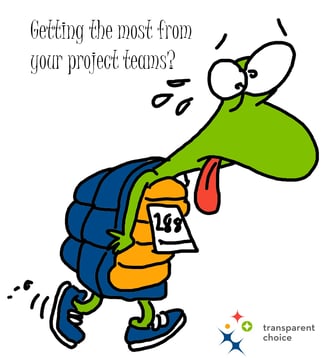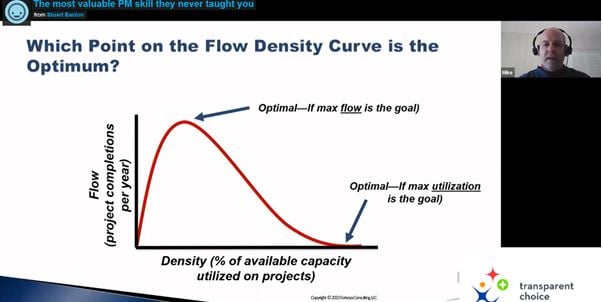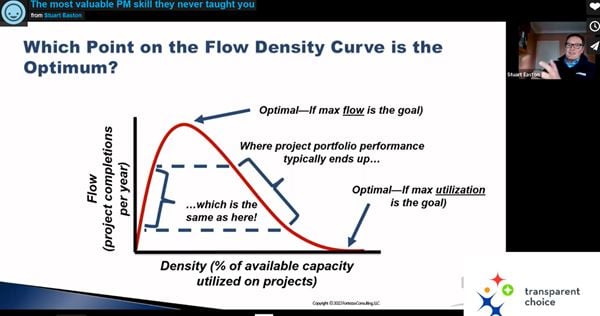Optimize Project Flow: Make projects go faster by slowing down!
Updated:
Published:
 My son has recently taken up running. I keep telling him to pace himself, but he doesn’t. He blasts out and, after a couple of hundred meters, has to walk for a bit. Then he’s off again.
My son has recently taken up running. I keep telling him to pace himself, but he doesn’t. He blasts out and, after a couple of hundred meters, has to walk for a bit. Then he’s off again.
He gets to the end. He’s exhausted and his dear old dad is already there, waiting for him.
Did dad sprint? No, I certainly did not!
I ran steadily and slowly, but I beat him.
How did an overweight, middle-aged guy beat his teenage son? Well, I know something that he doesn’t. I know a little about the theory of constraints… and what I know can transform your project delivery flow.
Understanding Project Flow and Bottlenecks
Most of what I know about the theory of constraints I learned from Mike Hannan. Mike is a real thought-leader on applying theory of constraints to project delivery. It’s not unusual for Mike’s customers to double, triple or even quadruple their project throughput.
We recently had Mike do a quick webinar outlining the key concepts and it’s a cracker. You can watch the full webinar at the bottom of this blog, or watch the short video below to get the “concentrated version”.
The key point is that the flow of anything - projects, water, oxygen in the body when running – is limited by the bottlenecks in the system. If you try to exceed the capacity of that bottleneck, you actually slow down.
In the clip, Mike shows a good example of water flowing out of a bottle.
Resource Utilization and Project Flow
So… you’re a PMO. You have 200 project resources, but their utilization rate is only 50%.
It’s obvious how to increase project flow, right? Just pile on more projects and drive up utilization.
Well, that works for a while… but at some point, flow actually slows down. Here’s a screenshot from the webinar that shows this effect.

You can see from the graph that the point at which you maximize flow is NOT THE SAME as the point at which you maximize utilization. If you’re on the right-hand side of this chart, reducing the load on the system a little will actually increase the flow of completed projects!
So, coming back to the running metaphor, running slower means you don’t run out of oxygen / pump too much lactic acid into your muscles so you can keep going and reach your destination quicker.
Boosting Project Flow by Working Smart, Not Hard
Most organizations tend to move up and down the right-hand side of the graph, well past the peak. What’s really interesting about that is that you could work a LOT less and get the same level of project flow!

Again, this is a screenshot from the webinar and I want to use it to ask a question – where would you rather be? Here are your options:
- On the right-hand side, working really hard
- On the left-hand side, taking it easy yet delivering the same number of projects
- At the peak – working fairly hard, but man, we’re banging those projects out!
So which would you like to be?
Yeah. That’s what I thought.
Project Prioritization for Streamlining Project Flow
Now of course, not all projects are created equal and the business doesn’t really care how many projects you complete. What they care about is how much business value you deliver.
Your organization structure/processes will dictate the maximum project flow rate. There are ways to improve the flow rate (the webinar mentions some of them), but there is always a limit.
This is why project prioritization is absolutely critical to increasing the flow of business value.
Project prioritization is how you identify WHICH projects will add the most value and if your capacity is limited, you had better make sure every project is really adding business value!
There are also good ways and bad ways to do project prioritization. I won’t cover that here, but if you want to learn more, you can see our Ultimate Guide to Project Prioritization.
To explore how our software can help your organization to build a powerfully effective prioritization process, book a demo session which we will tailor to your individual needs...
Strategies for Enhancing Project Flow
So, in summary, don’t be like my son on a run – don’t try to go flat-out all the time. It just doesn’t work and, in fact, slows you down.
Your capacity is limited. Your task is to deliver maximum business value from the capacity you have and here are the three steps you can take:
- Make sure you prioritize the most important projects
- Find the project load that maximizes project throughput for your current organization
- Then, work to increase your maximum project flow-rate
Webinar: The Most Valuable Portfolio Management Skill They Never Taught You
Michael Hannan of Fortezza Consulting shares a single high-powered technique to help transform any PMO into an impact-maximizing function. Mike describes the typical “vicious cycle” that current PMO environments are typically stuck in, and shows how any organization—with a bit of courageous leadership—can “flip” this vicious cycle to virtuous.
The presentation offers a more mission-driven set of key performance indicators (KPIs), exposes the myths of consistency and compliance, and teaches a simple yet powerful technique any organization can use to get much closer to its true potential.
Mike is a leading consultant, an innovative thought leader, a best-selling author and an inspiring speaker, so the webinar is well worth a listen!
Achieve Project Flow Excellence - Schedule Your Demo Now!
Is your team ready to overcome the challenges that slow down project delivery? Our individualised software demo offers the insights and tools necessary to streamline your processes and enhance portfolio performance for your organization.

